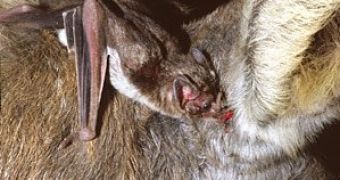If you think vampires exist just in books, movies and the rich imagination of some people, you're wrong. There are real vampires which have bat wings, are nocturnal, feed on blood and kill tens of people every year.
But the similarities with Bram Stroker's character Dracula - who served as the 'prototype' for vampires in modern western culture and was inspired by the Romanian Prince Vlad Dracul (which means "The Devil" in Romanian), also known as "Vlad the Impaler", as his favorite method of torture and execution was impaling people - stop here.
They do not live in Romania, but in subtropical and tropical America, from southern Mexico to northern Argentina. And not only that these vampire-bats living in Costa Rica cannot be chased away with garlic and crosses, but their number is increasing as they have found an easier source of food: cattle blood, much more accessible than stealing the blood of some nasty wild beast from the forest, like tapirs or peccaries.
As any vampire, the blood eating bats have something evil in them: while most species are affected by human activity and the way humans disturb the environment, in fact they thrive. Turning rainforests into farms with livestock is good news for the vampires of tropical America.
Farmers have noticed massive vampire bats attacking cattle recently. Sometimes, they can attack humans and transmit rabies (this is how human fatalities appear). To check the information received from farmers, a team led by Christian Voigt of the Leibniz Institute for Zoo and Wildlife Research in Berlin measured carbon isotopes in exhaled carbon dioxide in both captive and wild vampire bats. "The potential victims of vampires in Costa Rica are either cattle or rainforest mammals such as tapirs and peccaries," said Voigt.
But as any species relies on different plants for feeding, their isotope signature in breathing is different. "Therefore, we expected that the stable carbon isotope signature in bat breath would change according to their diet. The bat breath showed the chemical marks of cattle, indicating that the last blood meal of the flying mammals almost always was cattle.", said Voigt.
"The vampire bats don't necessarily prefer bovine blood, but cattle are held in fenced-in open pastures, making them and their blood much more accessible than that of free-roaming rainforest mammals.", signaled the researchers.

 14 DAY TRIAL //
14 DAY TRIAL //